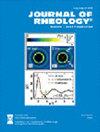关于蠕虫状胶束网络的启动行为:不同盐与同一表面活性剂分子结合的影响
IF 3.2
2区 工程技术
Q2 MECHANICS
引用次数: 2
摘要
我们报道了两种类似蠕虫的胶束溶液的剪切启动数据,这两种溶液的不同之处仅在于两种结合芳香族钠盐的浓度和类型。表面活性剂分子是固定浓度(100 mM)。水杨酸钠(NaSal)和双氯芬酸钠(Diclo)用作浓度为68的结合盐 mM NaSal和52 mM-Diclo,使得两个系统完全纠缠并且它们的线性粘弹性响应基本上相同。这两个系统都显示出蠕虫状胶束溶液的典型线性响应,在低频下具有末端行为,具有明确的模量交叉和平台模量。然而,在非线性状态下,两个系统的行为完全不同,这表明盐的分子结构差异及其与表面活性剂分子的结合活性对决定快速流动行为都至关重要。NaSal溶液表现出非常复杂的流变响应,具有应变硬化和非常尖锐的应力峰值,而含有Diclo的溶液表现得非常像普通线性聚合物,在接近稳态之前,在瞬态剪切粘度中表现出明显的过冲和适度的下冲。通过将数据与最近采用的纠缠聚合物和线性蠕虫状胶束的本构方程的预测进行成功比较,也证明了这种类似聚合物的行为。就NaSal而言,基于橡胶网络理论建立了一个描述流动奇点的现象学模型。还提出了对非线性状态下不同行为的物理解释。本文章由计算机程序翻译,如有差异,请以英文原文为准。
On the startup behavior of wormlike micellar networks: The effect of different salts bound to the same surfactant molecule
We report on shear startup data for two wormlike micellar solutions, differing only in concentration and type of two binding aromatic sodium salts. The surfactant molecule is cetylpiridinium chloride at a fixed concentration (100 mM). Sodium salicylate (NaSal) and diclofenac sodium (Diclo) are used as binding salts at concentrations 68 mM NaSal and 52 mM Diclo such that both systems are fully entangled and their linear viscoelastic response is essentially identical. Both systems show the linear response typical of a wormlike micellar solution, with terminal behavior at low frequencies, a well-defined moduli crossover, and a plateau modulus. In the nonlinear regime, however, the behavior of the two systems is totally different, suggesting that the molecular structure difference of the salts and their binding activity to the surfactant molecule are both crucial to determine the fast flow behavior. The NaSal solution shows a very complex rheological response, with strain hardening and very sharp stress peaks, whereas the solution containing Diclo behaves much like ordinary linear polymers, exhibiting pronounced overshoots as well as moderate undershoots in the transient shear viscosity, before approaching the steady state. This polymerlike behavior has also been proved by successfully comparing data with predictions of a constitutive equation recently adopted for both entangled polymers and linear wormlike micelles. As far as NaSal is concerned, a phenomenological model based on rubber network theory is developed, which describes the flow singularities. A physical interpretation of the different behavior in the nonlinear regime is also suggested.
求助全文
通过发布文献求助,成功后即可免费获取论文全文。
去求助
来源期刊

Journal of Rheology
物理-力学
CiteScore
6.60
自引率
12.10%
发文量
100
审稿时长
1 months
期刊介绍:
The Journal of Rheology, formerly the Transactions of The Society of Rheology, is published six times per year by The Society of Rheology, a member society of the American Institute of Physics, through AIP Publishing. It provides in-depth interdisciplinary coverage of theoretical and experimental issues drawn from industry and academia. The Journal of Rheology is published for professionals and students in chemistry, physics, engineering, material science, and mathematics.
 求助内容:
求助内容: 应助结果提醒方式:
应助结果提醒方式:


